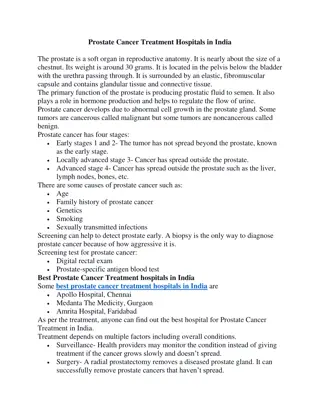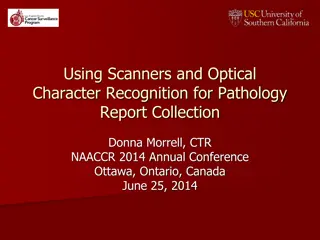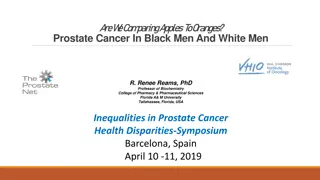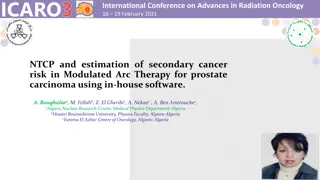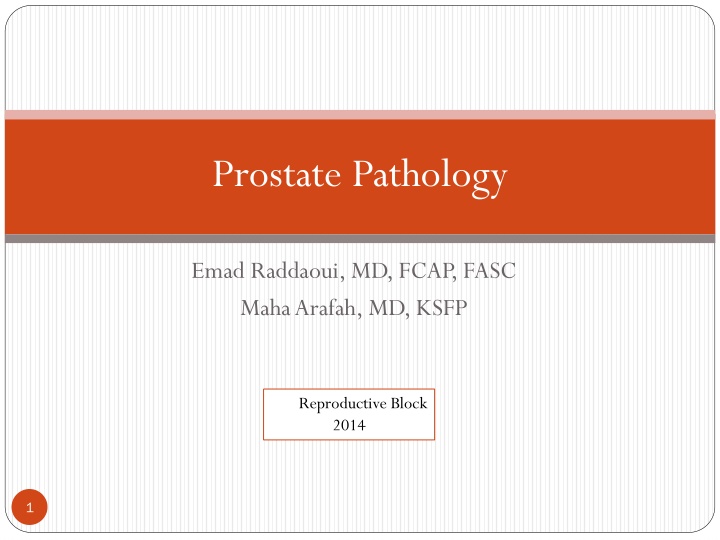
Benign Prostatic Hyperplasia (BPH) and Prostate Pathology
Explore the world of prostate pathology and delve into the intricacies of Benign Prostatic Hyperplasia (BPH) – its causes, clinical features, and morphological changes. Unravel the complexities of Prostatic Adenocarcinoma, touching on its morphology, spread, grading, staging, clinical course, and treatment options. Delve into the zones of the prostate and discover the normal histologic appearance of prostate glands. Join us on a journey to grasp the essence of BPH, an extremely common lesion in men over 50, with insights into its growth mechanisms and preventative measures.
Download Presentation

Please find below an Image/Link to download the presentation.
The content on the website is provided AS IS for your information and personal use only. It may not be sold, licensed, or shared on other websites without obtaining consent from the author. If you encounter any issues during the download, it is possible that the publisher has removed the file from their server.
You are allowed to download the files provided on this website for personal or commercial use, subject to the condition that they are used lawfully. All files are the property of their respective owners.
The content on the website is provided AS IS for your information and personal use only. It may not be sold, licensed, or shared on other websites without obtaining consent from the author.
E N D
Presentation Transcript
Prostate Pathology Emad Raddaoui, MD, FCAP, FASC MahaArafah, MD, KSFP Reproductive Block 2014 1
Objectives: At the end of the lecture, the student are expected to be able to: Define Benign Prostatic Hyperplasia, mention its causes, clinical features and morphological changes. List the causes of Prostatic Adenocarcinoma, its morphology, spread, grading and staging, clinical course and treatment options.
Prostate gland Prostate weighs 20 grams in normal adult Retroperitoneal organ, encircling the neck of bladder and urethra Devoid of a distinct capsule Divided into four biologically and anatomically distinct zones or regions: the peripheral, central, and transitional zones, and the region of the anterior fibromuscular stroma Histologically the prostate is composed of glands lined by two layers of cells: a basal layer of low cuboidal epithelium covered by a layer of columnar secretory cells 3
Zones of the Prostate Peripheral Central Transitional Most hyperplasias arise in the transitional zone, whereas most carcinomas originate in the peripheral zone. 4
The normal histologic appearance of prostate glands and surrounding fibromuscular stroma A small pink concretion (typical of the corpora amylacea seen in benign prostatic glands) appears in the gland just to the left of center. Note the well-differentiated glands with tall columnar epithelial lining cells. These cells do not have prominent nucleoli. 6
Benign Prostatic Hyperplasia Benign Prostatic Hyperplasia
Benign Prostatic Hyperplasia (BPH) Extremely common lesion in men over age 50 (20% in men over age 40, up to 70% by age 60, and 90% by age 70). Hyperplasia of glands and stroma Fairly large, well defined nodules Related to the action of androgen DHT, Dihydrotestesterone is the ultimate mediator for prostatic growth Prepubertal castration prevents BPH 8
BPH, Clinical Features - Occur in only about 10% of men with the disease. - lower urinary tract obstruction. - Difficulty in starting the stream of urine (hesitancy) and intermittent interruption of the urinary stream while voiding. - Some men may develop complete urinary obstruction, with resultant painful distention of the bladder and, if neglected, hydronephrosis - Symptoms of obstruction are frequently accompanied by urinary urgency, frequency, and nocturia, all indicative of bladder irritation. - The combination of residual urine in the bladder and chronic obstruction increases the risk of urinary tract infections. 9
BPH, Morphology The prostate weighs between 60 and 100 grams ( normal 20 gm) Almost exclusively in the transitional zone of the prostate gland Nodules, vary in color and consistency 10
BPH, Morphology The hallmark of BPH is nodularity due to glandular proliferation or dilation and to fibrous or muscular proliferation Aggregation of small to large to cystically dilated glands Needle biopsy doesn t sample the transitional zone where BPH occur 11
A normal prostate gland is about 3 to 4 cm in diameter. This prostate is enlarged due to prostatic hyperplasia, which appears nodular. Thus, this condition is termed either BPH (benign prostatic hyperplasia) or nodular prostatic hyperplasia 12
Nodules appear mainly in the lateral lobes. Such an enlarged prostate can obstruct urinary outflow from the bladder and lead to an obstructive uropathy 13
The enlarged prostate gland seen here not only has enlarged lateral lobes, but also a greatly enlarged median lobe that obstructs the prostatic urethra. This led to obstruction with bladder hypertrophy, as evidenced by the prominent trabeculation of the bladder wall seen here from the mucosal surface. Obstruction with stasis also led to the formation of the yellow-brown calculus (stone). 14
BPH can involve both glands and stroma, though the former is usually more prominent. Here, a large hyperplastic nodule of glands The glands are well-differentiated and still have some intervening stroma. The small laminated pink concretions within the glandular lumens are known as corpora is seen. amylacea. 15
Prostatic Adenocarcinoma Adenocarcinoma of the prostate is the most common form of cancer in men Second leading cause of cancer death Disease of men over age 50 More prevalent among blacks in the USA Etiology Several risk factors : Age, race, family history, hormone level and environmental influences Androgen are believed to play a role in the pathogenesis 17
Prostatic Adenocarcinoma, Morphology 70% arises in the peripheral zone of the gland Palpable in rectal exam cross-section of the prostate the neoplastic tissue is gritty and firm 18
Prostatic adenocarcinoma. Irregular yellowish nodules. Prostate glands containing adenocarcinoma are not necessarily enlarged. Adenocarcinoma may also coexist with hyperplasia. However, prostatic hyperplasia is not a premalignant lesion 19
At high magnification, the neoplastic glands of prostatic adenocarcinoma are still recognizable as glands, but there is no intervening stroma and the nuclei are hyperchromatic. 20
Poorly differentiated prostatic adenocarcinoma demonstrates cells with nucleoli and mitotic figures. 21
Prostatic Adenocarcinoma, Microscopic The glands are typically smaller than benign glands and are lined by a single uniform layer of cuboidal or low columnar epithelium. In contrast to benign glands, prostate cancer glands are more crowded, and characteristically lack branching and papillary infolding. The outer basal cell layer typical of benign glands is absent. Nuclei are large and often contain one or more large nucleoli Peri-neural invasion is common and typical 22
Spread of prostatic Adenocarcinoma By direct local invasion and through blood stream and lymph Local extension most commonly involves the seminal vesicles and the base of the urinary bladder Hematogenous extension occurs chiefly to the bones The bony metastasis are typically osteoblastic 23
Prostatic Adenocarcinoma: Grading and Staging Gleason grading system is the best known for grading Five grades on the basis of glandular pattern and degree of differentiation as seen under low magnification Grading is of particular important in prostate cancer, because it is the best marker, along with the stage, for predicting prognosis Staging in prostate cancer depends on the TNM system 24
Prostatic Adenocarcinoma: Clinical Course Microscopic cancers are asymptomatic, discovered incidentally Patients with clinically localized disease do not have urinary symptoms Most arise peripherally, away from urethra, therefore, urinary symptoms occur late 25
Prostatic Adenocarcinoma, Clinical Course Careful digital exam may detect some early cancers PSA (Prostate Specific Antigen) has been used in the diagnosis and management of prostate cancer PSA is organ specific but not cancer specific Could be increased in BPH 26
Prostatic Adenocarcinoma, Treatment Surgery, radiotherapy and hormonal therapy 90% of treated patients expected to live for 15 years Currently the most acceptable treatment for clinically localized cancer is radical surgery Locally advanced cancers can be treated by radiotherapy Hormonal therapy (Anti-androgen therapy) could induce remission 27

